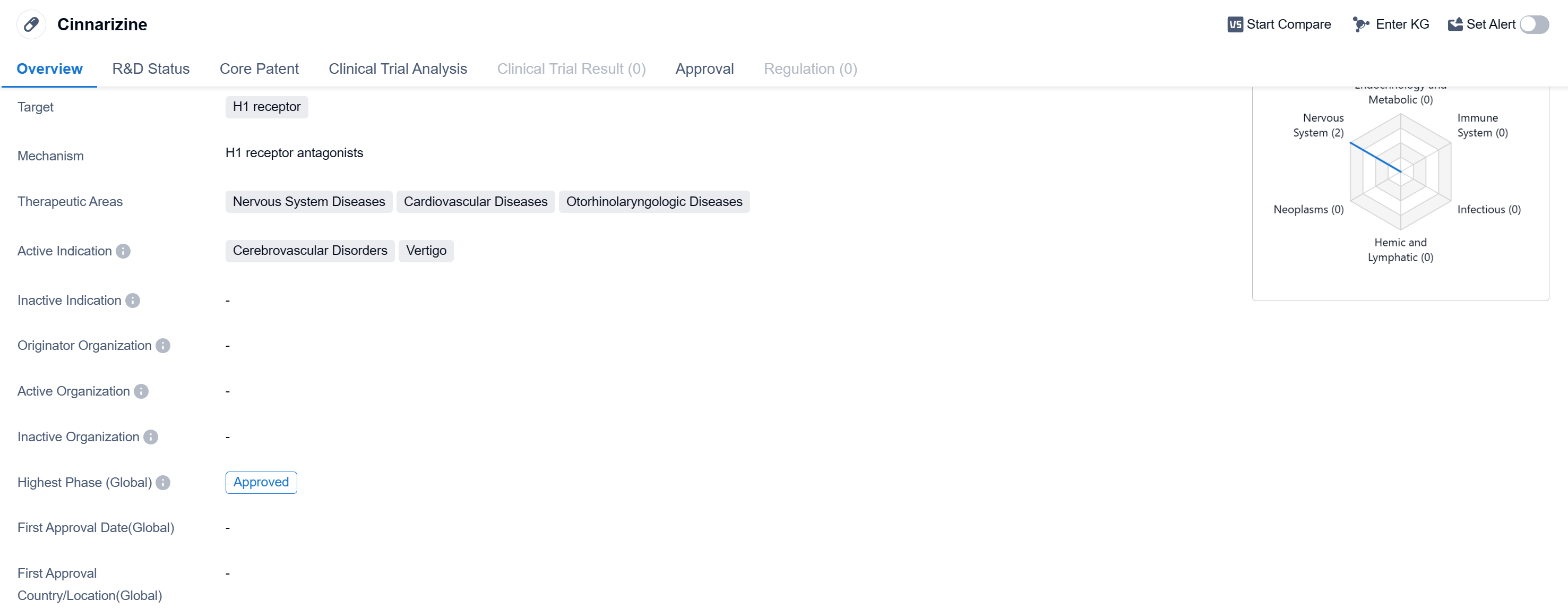Exploring Cinnarizine's Revolutionary R&D Successes and its Mechanism of Action on Drug Target
Cinnarizine's R&D Progress
Cinnarizine is a small molecule drug that primarily targets the H1 receptor. It is used in the treatment of various nervous system diseases, cardiovascular diseases, and otorhinolaryngologic diseases. The active indications for Cinnarizine include cerebrovascular disorders and vertigo.
Cinnarizine has reached the highest phase of approval globally. This suggests that the drug has met the necessary regulatory requirements and can be prescribed by healthcare professionals for the approved indications.
Similarly, Cinnarizine has also obtained approval in China, indicating its acceptance and recognition in the Chinese pharmaceutical market. This approval further highlights the drug's potential benefits and suitability for patients in China.
The therapeutic areas targeted by Cinnarizine, namely nervous system diseases, cardiovascular diseases, and otorhinolaryngologic diseases, encompass a wide range of medical conditions. Nervous system diseases refer to disorders affecting the brain, spinal cord, and nerves, while cardiovascular diseases involve conditions related to the heart and blood vessels. Otorhinolaryngologic diseases pertain to disorders of the ear, nose, and throat.
Cerebrovascular disorders, one of the active indications for Cinnarizine, are conditions that affect the blood vessels supplying the brain. These disorders can lead to various complications, including stroke and transient ischemic attacks. Vertigo, another active indication, is characterized by a spinning sensation and can be caused by various factors, including inner ear problems.
👇Please click on the image below to directly access the latest data (R&D Status | Core Patent | Clinical Trial | Approval status in Global countries) of this drug.
Mechanism of Action for Cinnarizine: H1 receptor antagonists
H1 receptor antagonists, also known as H1 antihistamines, are a class of drugs that block the action of histamine at the H1 receptors in the body. Histamine is a chemical released by the immune system in response to allergens, causing symptoms such as itching, sneezing, runny nose, and watery eyes. H1 receptor antagonists work by binding to the H1 receptors, preventing histamine from attaching to these receptors and thereby reducing the allergic response.
From a biomedical perspective, H1 receptor antagonists are commonly used in the treatment of allergies, including allergic rhinitis (hay fever), allergic conjunctivitis, and urticaria (hives). They can help alleviate symptoms such as itching, sneezing, and nasal congestion. Some examples of H1 receptor antagonists include cetirizine, loratadine, and fexofenadine. These medications are available over-the-counter or by prescription, depending on the specific drug and dosage strength. It is important to note that H1 receptor antagonists may cause drowsiness as a side effect, although newer generations of these drugs have been developed to minimize this effect.
Drug Target R&D Trends for Cinnarizine
According to Patsnap Synapse, as of 13 Sep 2023, there are a total of 270 H1 receptor drugs worldwide, from 281 organizations, covering 131 indications, and conducting 1721 clinical trials.
The analysis of the target H1 receptor reveals a competitive landscape with multiple companies actively developing drugs. GSK Plc, Sanofi, and Bayer AG have the highest stage of development on this target. The indications with the highest number of approved drugs include rhinitis, allergic, and the common cold. Small molecule drugs are the most rapidly progressing drug type, indicating intense competition. China is developing rapidly in this target, with a significant number of approved drugs.
The future development of the target H1 receptor is likely to be driven by continued research and development efforts from pharmaceutical companies, with a focus on addressing indications such as rhinitis, allergic, and the common cold. The competition in the small molecule drug space, including biosimilars, is expected to remain intense. China's progress in this target presents potential market opportunities and collaborations for international pharmaceutical companies.
Overall, the target H1 receptor represents a promising area for pharmaceutical development, with a diverse range of companies, indications, drug types, and countries/locations involved. Further research and analysis can provide deeper insights into the specific strategies and future developments in this target.
👇Please click on the picture link below for free registration or log in directly if you have a freemium account, you can browse the latest research progress on drugs, indications, organizations, clinical trials, clinical results, and drug patents related to this target
Conclusion
In summary, Cinnarizine is a small molecule drug that targets the H1 receptor and is used in the treatment of nervous system diseases, cardiovascular diseases, and otorhinolaryngologic diseases. It has obtained approval in the global markets. The active indications for Cinnarizine include cerebrovascular disorders and vertigo, highlighting its potential benefits for patients suffering from these conditions.






